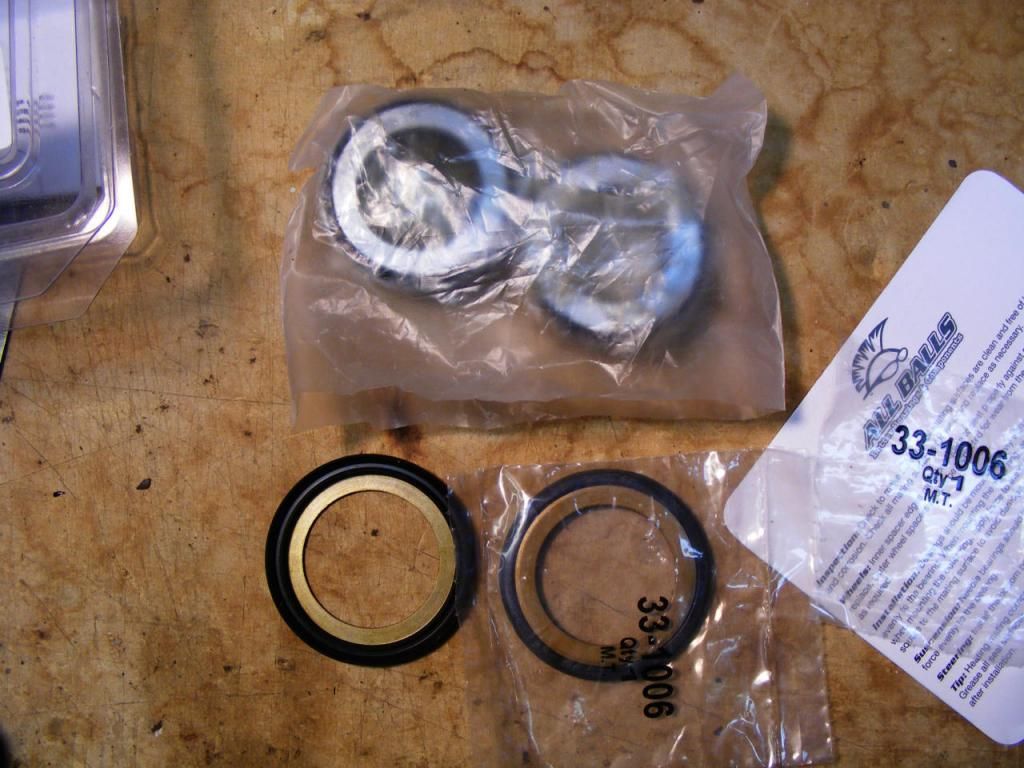yeadon_m wrote:If these are tapered roller bearings, you can thin the steering stem a fraction using a file or dremmel tool to allow the top bearing to drop down a bit lower and close up the headlamp bracket gap. I've done this 3 times on GTs with All Balls tapered sets. They're meant to be a drop-in replacement but they're not quite that.
I also left out the seals. I did put a huge dollop of LM grease in the steering head as well as to drive grease curly fashion into the bearings!
Cheers,
Mike
Okay, so I am doing this right now, and I'll throw in my findings to (hopefully) assist others who do it. Sorry if it's bit long-winded.
I needed to machine the top section of my steering stem to fit the top taper bearing inner race. The instructions that came with the AllBalls Taper Roller bearing conversion kit recommended machining the top of the steering stem (just below the bearing adjuster nut thread) down from 10mm to 16mm to the diameter of the existing machining (24.85mm in my case). The machined section is the shiny bit just below the thread that the bearing adjustor nut runs on. My stem was machined to a slightly differently measurement to the AllBalls instruction sheet. (8mm down from the threaded section as opposed to AllBalls stated 10mm). No drama... I think the key is to machine down at least 16mm below the bottom of the threaded section. I don't think it would matter if you went down further anyway. It's the diameter and alignment that's more important
The taper bearing inner race has to be able to slide up/down the stem without any play or any slop, so that the taper bearing can be adjusted so that there is virtually zero clearance and zero drag. This machining is not a dead easy job on your average 'roughie home workshop' lathe (such as my 110 year old Seneca!!!). I set it up so that the top end of the stem was chucked, and the lower end with the lower triple clamp was mounted in a live centre in the tailstock. One issue is that that the lower triple clamp is a large out of balance spinning mass quite a long way from the machining zone, that when chucked up with the live centre at the lower triple clamp end can cause a vibration that can affect the accuracy of the cut, plus it's not easy to get a perfect alignment of the top of the stem and the lower end/triple clamp. Of course with sophisticated machinery it may be a little easier, but I suspect that even with super CNC machinery, the imperfections of the (40 year old) stem assembly would make it hard to get it perfect. (Best I could manage was a radial .0015" error).
The ideal obviously is a perfect alignment of the new cut to the original machined diameter. The way I'm looking at it is this: The taper-roller bearing adaptation means that you need to get a little more machined area down the stem so that the top inner race will be able to slide down further to it's correct position when the taper roller bearing is adjusted correctly. The new race will be in a slightly lower position on the stem than the original ball race. You need a pretty accurate cut to get this right. My guess is that the 'new' cut should be -if there is any error - SLIGHTLY smaller diameter than the existing machined diameter. so the existing machined diameter will provide the correct alignment and 'fit', but the extra 'new' machining will allow the bearing inner to slide down a little more on the stem.
(Machinists please correct me if I'm wrong!) I'll let ya's know how I go when I come to assemble the thing.
I intend to use the supplied grease seals, I'll see how they go. (Doesn't seem a problem to me to pack out the headlamp mounts if needed).

